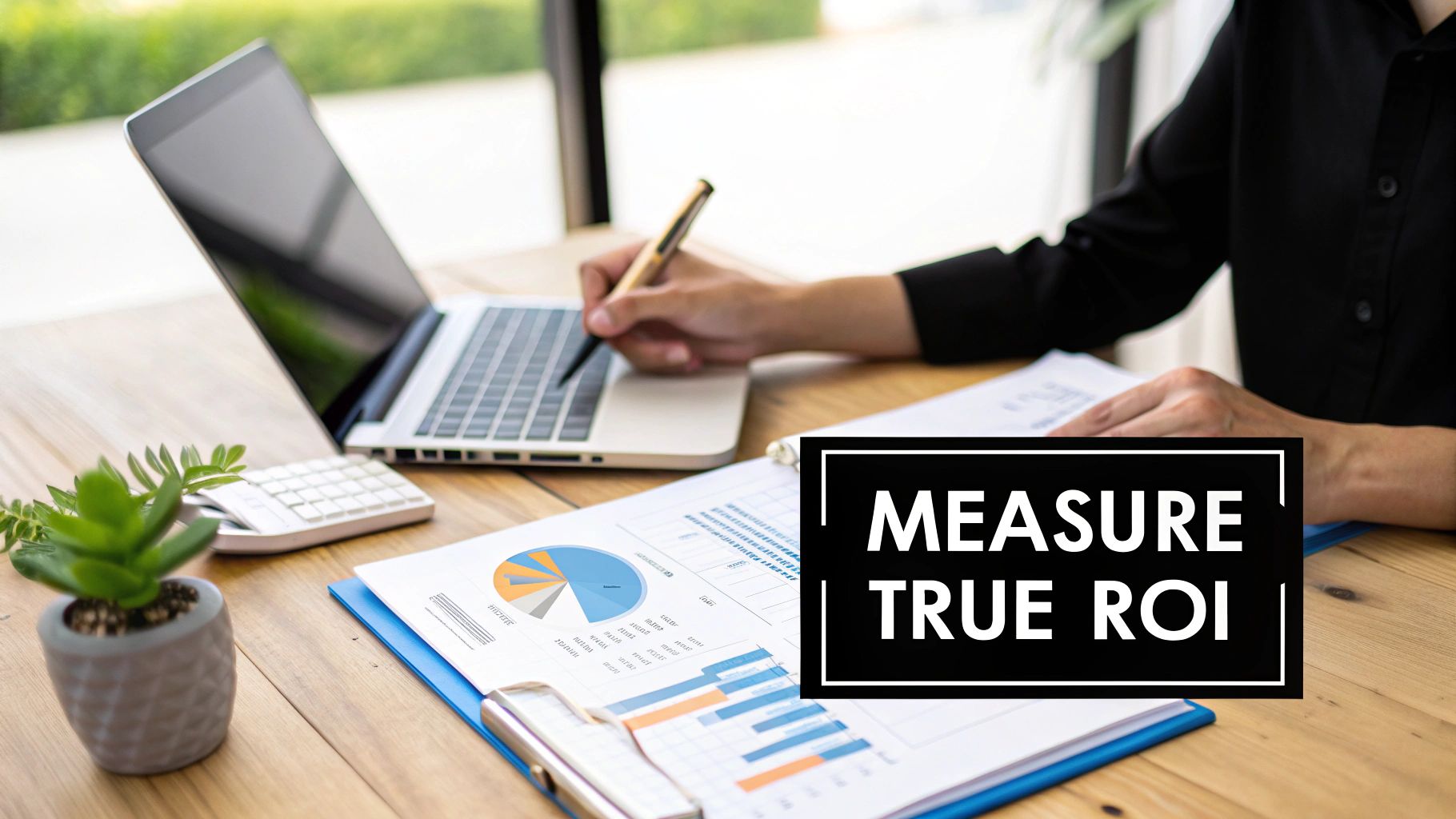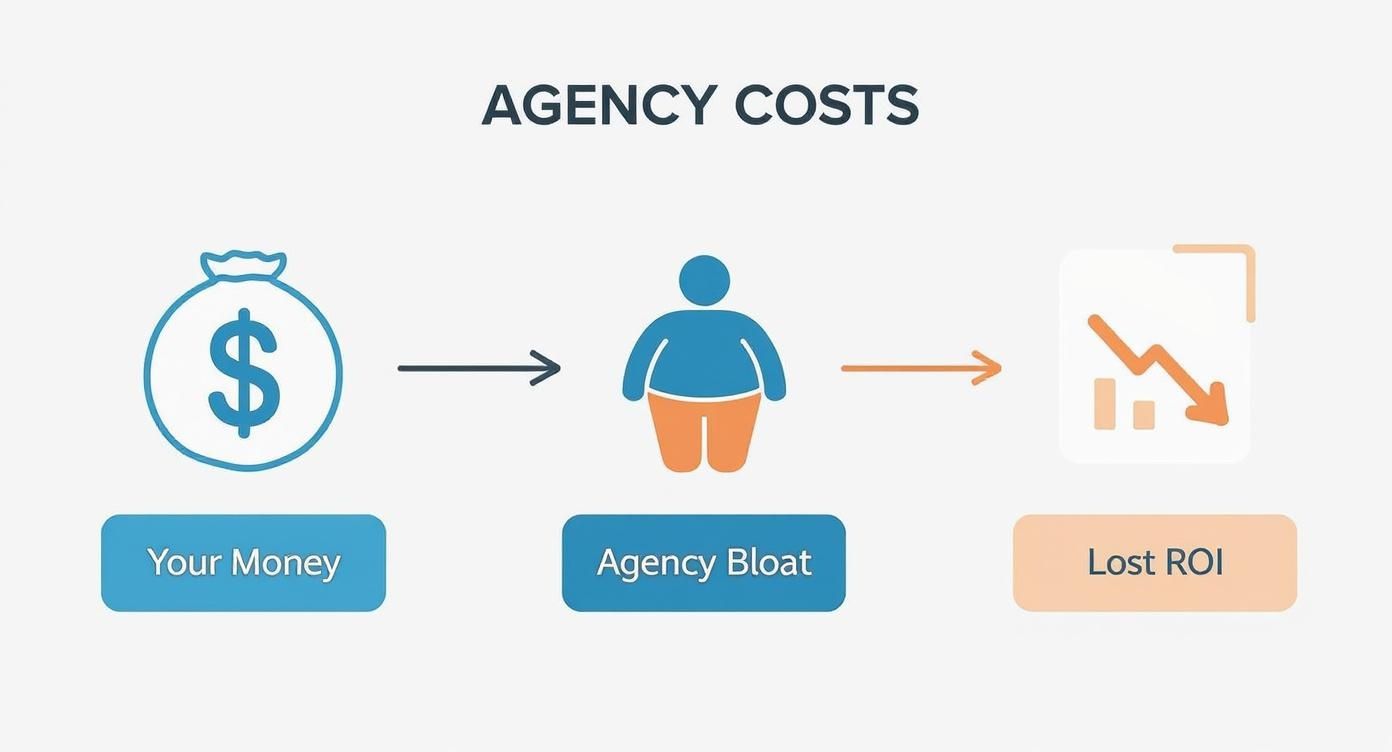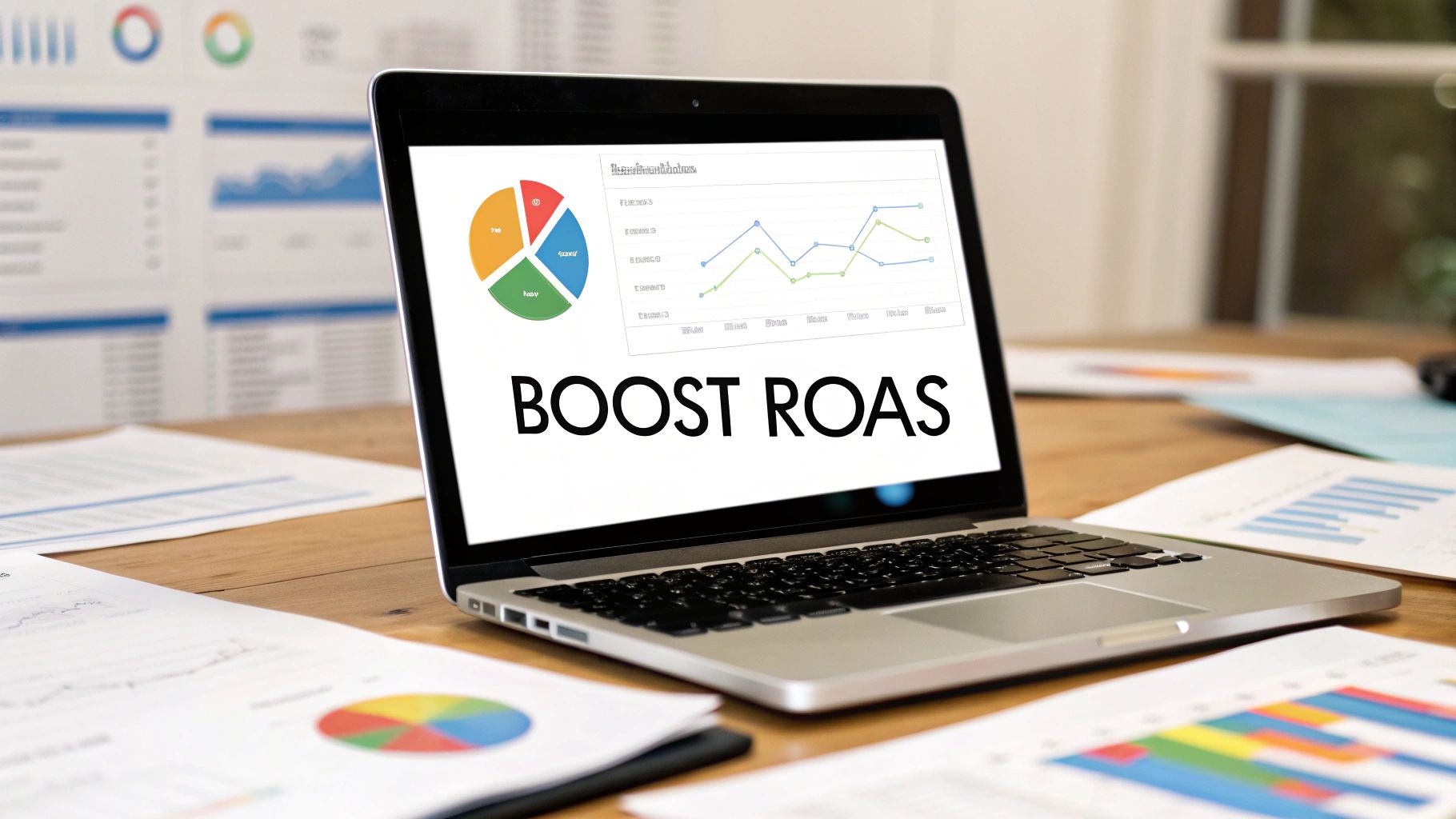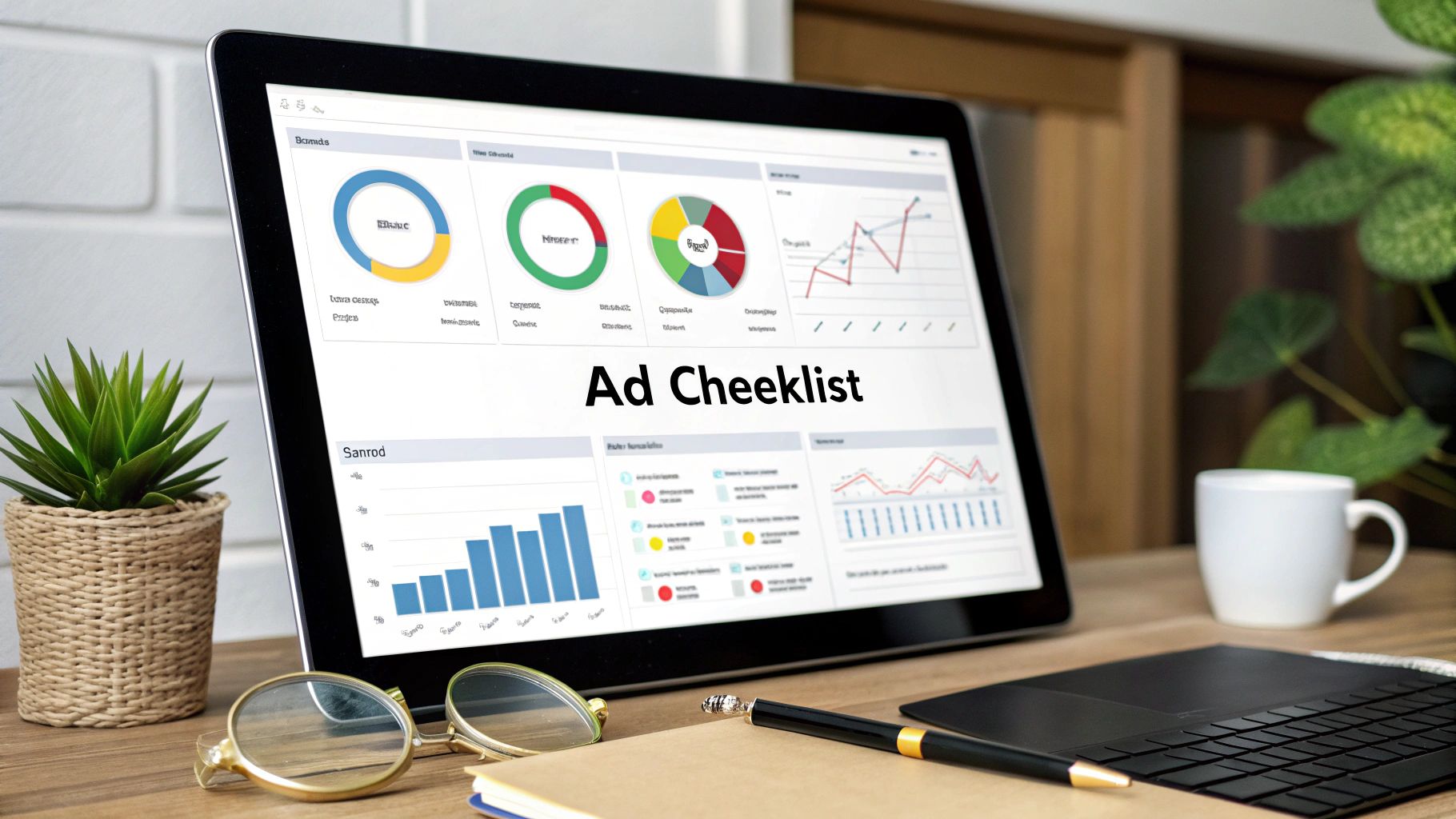measuring return on marketing investment: a practical guide
- Chase McGowan

- 38 minutes ago
- 16 min read
Forget the agency jargon for a second. Let's talk about what actually matters: your bottom line.
For far too long, businesses have been sold on a diet of vanity metrics. Clicks, impressions, even lead volume—they look great in a slick monthly report, but they don't pay the bills. This is a classic move by bloated agencies to justify their fees without ever having to prove their actual worth.
As a dedicated Google Ads consultant, my entire approach is different. Measuring return on marketing investment isn't just a box-ticking exercise; it's the absolute core of a winning growth strategy. It’s about drawing an undeniable line between every dollar you spend and the profit it generates.
Moving Beyond Clicks to True Marketing ROI

The Specialist's Focus: Profit, Not Presentations
Big agencies often get lost in their own bureaucracy. Between layers of management and internal meetings, their main goal becomes justifying their own overhead. Their reports are often confusing by design, packed with metrics that deliberately obscure the one question you should be asking: "Are we making money from this?"
A dedicated consultant, on the other hand, has one focus: your profitability.
The goal isn't just to make campaigns look good. It's to make them be good in the only way that counts. This means we stop asking, "How many clicks did we get?" and start asking the real questions:
What's our Customer Lifetime Value (CLV)? We need to know the total worth of a customer over time, not just what their first purchase was worth.
How does ad spend impact long-term growth? Are we just buying one-off sales, or are we acquiring loyal customers who will drive sustainable revenue?
Is our tracking system actually capturing every dollar? Bad data leads to bad decisions. My first priority is always building a bulletproof tracking foundation.
The real difference comes down to accountability. An agency might sell you on the complexity of their process. A consultant delivers clarity on your profit. My success is directly tied to yours—no layers of bureaucracy to hide behind.
Redefining Success with Tangible Outcomes
The concept of Return on Marketing Investment (ROMI) isn't new. It became an essential metric back in the early 2000s, thanks to publications like James Lenskold’s 'Marketing ROI' that cemented its importance.
The formal calculation looks something like this: ((Incremental Revenue Attributable to Marketing × Contribution Margin) – Marketing Spending) ÷ Marketing Spending.
But here’s the thing: anyone can plug numbers into a formula. The real expertise lies in knowing what those numbers should be. It requires a deep understanding of what counts as "incremental revenue" and how to attribute it accurately—something most agencies just generalize.
By focusing on profit-driven metrics from day one, we set the stage for a smarter, more accountable way to manage your marketing budget. This groundwork is the first critical step as you learn how to measure advertising effectiveness across all your campaigns.
This isn't just about running ads. It's about building a predictable engine for business growth.
Why Agency Bloat Destroys Your Marketing ROI
Ever get that sinking feeling looking at an agency invoice, wondering where your money actually went? It’s a common story, and the truth is often a tough pill to swallow. A huge slice of your marketing budget probably isn't going toward expert strategy or campaign optimization. It's feeding the agency machine.
This "agency bloat" is one of the biggest—and quietest—killers of marketing ROI. Your funds get watered down before a single dollar is ever spent on an ad. Why? Because big agencies are built on layers of overhead, and you, the client, are the one footing the bill without even realizing it.
Think about it: fancy high-rise offices, layers of management, and bloated support staff. The person actually running your campaigns is often a junior specialist, while your main point of contact is an account manager juggling you and a dozen other clients. Their real job isn't to maximize your profit; it's to keep you happy enough to sign the next retainer check.
The Hidden Costs Sucking Up Your Investment
When you calculate ROI, that "investment" part of the equation is everything. But agencies inflate this number with costs that have zero to do with your campaign’s performance. The money gets spread thin across people and processes that don't add a lick of direct value.
Imagine your monthly budget flowing through their typical structure:
Account Director: High-level relationship manager.
Account Manager: Your day-to-day contact, mostly playing telephone.
Project Coordinator: Pushes timelines internally.
Junior PPC Specialist: The one actually in the weeds, often just following a generic playbook.
By the time your budget trickles down to the person doing the work, a massive chunk has been eaten up by salaries and overhead. This top-heavy structure means less of your money goes toward strategic thinking and hands-on work that actually moves the needle.
A bloated agency model makes you pay for their inefficiencies. When you work with a specialist, your entire investment goes directly into expertise and execution—the two things that actually impact your bottom line.
A Real-World Scenario: Consultant vs. Agency
Let’s put some real numbers to this. Picture an e-commerce brand with $10,000 a month to put toward Google Ads.
Scenario 1: The Bloated Agency
The business pays a $3,000 monthly retainer. Of that, maybe $500 actually covers the time of the junior specialist working on the account. The other $2,500 is paying for the account manager, the director, a project manager, and a piece of the agency's rent. The remaining $7,000 is left for ad spend.
The junior specialist, stuck with a one-size-fits-all process, pulls in a 4:1 Return on Ad Spend (ROAS).
Total Investment: $3,000 (retainer) + $7,000 (ad spend) = $10,000
Revenue Generated: $7,000 (ad spend) x 4 (ROAS) = $28,000
Marketing ROI: (($28,000 - $10,000) / $10,000) = 180%
It looks decent, right? But so much of that investment was vaporized before it even had a chance to perform.
Scenario 2: The Expert Consultant
Now, the same business hires a specialist consultant for a $1,500 monthly fee. Every dollar of that fee pays for expert-level strategy and hands-on management. No middlemen, no unnecessary overhead. This leaves $8,500 to go directly to ad spend.
The consultant, bringing years of focused experience, makes smarter, faster optimizations and hits a 5:1 ROAS.
Total Investment: $1,500 (fee) + $8,500 (ad spend) = $10,000
Revenue Generated: $8,500 (ad spend) x 5 (ROAS) = $42,500
Marketing ROI: (($42,500 - $10,000) / $10,000) = 325%
The difference is night and day. By cutting the bloat, the business spent less on management, put more money directly into ads, and got far better expertise. The result was a massively higher and more transparent ROI. This is why properly measuring return on marketing investment starts with making sure your "I" is as lean and effective as possible.
Building a Data Foundation for Accurate ROI Tracking
You can’t measure real ROI with a flimsy spreadsheet or a glossy agency report. It has to be built on a rock-solid data foundation—and you'd be surprised how many large agencies cut corners right here. Without clean, reliable data, any ROI calculation is just a sophisticated guess, and that’s a dangerous way to run a business.
This is where the difference between a specialist and a typical agency becomes glaringly obvious. An agency might set up basic conversion tracking and call it a day, but that only gives you a tiny piece of the puzzle. My first job is always to make sure every single dollar is tracked meticulously, from the first ad click all the way to the final sale and beyond.
The journey your marketing investment takes when filtered through layers of agency overhead is costly, and it actively shrinks your true ROI before your campaigns even get a chance to perform.

This visual really drives the point home. It shows how agency bloat intercepts your investment, siphoning off funds for their own overhead before that money can ever generate a return for you.
Going Beyond the First Sale
Most agencies live and die by tracking the initial transaction. A customer clicks an ad, buys something, and the agency chalks it up as a win. This approach isn't just shortsighted; it completely ignores the real value of that new customer.
What about their second purchase? Or their third? What if they stick around for the next five years? Tracking only the first sale gives you a warped, incomplete picture of your marketing ROI.
To get the real story, you have to focus on Customer Lifetime Value (CLV). This metric isn't just a number; it's the total profit you can expect from a customer over the entire relationship. When we optimize campaigns for high-CLV customers—not just one-off sales—we start building a sustainable, profitable growth engine. It’s a strategic depth you’ll rarely find with an agency that's just scrambling to hit basic ROAS targets for their monthly report.
Many agencies fail because they treat data tracking as a one-time technical setup, not a core business strategy. A specialist sees it differently: Your data foundation isn't about counting conversions; it's about understanding customer value so you can acquire more of your best customers.
The Tools of a Bulletproof Tracking System
Building this foundation doesn't mean using a dozen complicated tools. It’s about using the right ones, using them correctly, and making them talk to each other seamlessly.
Here are the non-negotiables I put in place for every single client:
Precise Google Ads Conversion Tracking: This is so much more than the default setup. We configure actions that actually matter—like actual sales, qualified leads, and key steps in the buyer journey—not just vanity clicks. To make any of this trustworthy, it's crucial to be proactive about solving data integrity problems from the start.
Deep Integration with Google Analytics 4 (GA4): Getting Google Ads and GA4 linked up correctly is essential. It lets us see the entire customer journey, including what users do on your site before they convert. This is how we find out which campaigns are attracting the most engaged, highest-value customers.
Implementing Value-Based Bidding: Instead of just telling Google to get you the most conversions possible, we tell it to find the most valuable conversions. By assigning dynamic values to different actions based on potential revenue or CLV, we train the algorithm to hunt for your most profitable customers, not just any customer.
Getting this technical setup right is absolutely critical. If you want to go deeper on this, our detailed guide can help you fix your Google Ads conversion tracking and sidestep the common mistakes.
Ultimately, a strong data foundation removes the guesswork from measuring return on marketing investment. It gives you the clarity to see exactly what’s working, what isn’t, and where your next dollar will generate the most profit. This isn’t something you can afford to gloss over, and it's where a dedicated expert provides immediate, lasting value over a disconnected, generalist agency.
Choosing the Right Attribution Model for Your Business
Attribution. It’s the part of the conversation about measuring return on marketing investment where things get murky, fast—especially when you’re dealing with a typical agency.
Put simply, attribution is just how you give credit to the different marketing touchpoints that convince a customer to buy. Get it right, and you get incredible clarity. Get it wrong—the way most agencies do—and you end up hiding poor performance behind a wall of confusing data.
Big agencies almost always default to the simplest model, like Last-Click attribution. Why? Because it’s easy. It gives 100% of the credit for a sale to the very last ad a customer clicked. While that sounds straightforward, it creates a dangerously incomplete picture by totally ignoring all the earlier interactions that introduced and nurtured that customer.
As a specialist, I don’t do defaults. My approach is to pick the model that actually mirrors your customer's journey. Your business isn't a generic template, so your attribution shouldn't be either.
Matching the Model to Your Business
The right attribution model is dictated entirely by your sales cycle and business model. Shoving every business into a one-size-fits-all box is a guaranteed way to misallocate your budget and kill your ROI.
Let’s look at a couple of real-world scenarios.
A Local Plumber: The customer journey here is short. It’s an emergency. Someone’s pipe bursts, they search "emergency plumber near me," click an ad, and make a call. Done. In this situation, Last-Click attribution is actually perfect. It correctly shows that the final, decisive action is what sealed the deal.
An E-commerce Furniture Brand: Now, imagine you sell high-end sofas with a six-week sales cycle. A customer might first discover your brand through a YouTube ad, click a Shopping ad a week later to browse, and finally convert by searching for your brand name directly. A Last-Click model would give all the credit to that last search ad and ignore the first two critical touchpoints. You’d probably end up cutting the budget for the very channels filling the top of your funnel.
This is exactly where a Data-Driven attribution model, available right inside Google Ads, is a game-changer. It uses machine learning to analyze all the touchpoints and assign fractional credit based on which ones actually influenced the conversion.
An agency clinging to a default Last-Click model for a business with a long sales cycle isn't just being lazy—they're actively misguiding your strategy. My job is to ensure we credit what truly drives growth, not just what's easiest to report.
Why Default Models Hide the Truth
Over-priced, bloated agencies love the simplicity of default models. They’re easy to explain on a report and don’t require any deep strategic thinking. They can point to a chart of last-click conversions, call it a day, and send the invoice—even if that data is telling a completely misleading story.
This lazy approach often leads to terrible decisions. For instance, they might see that your social media ads have very few last-click conversions and recommend slashing the budget. What they miss is that those same ads are introducing 70% of your new customers to your brand in the first place. You cut the budget, and your entire pipeline dries up a month later.
To help you choose the right model, I’ve put together a quick comparison of the most common options and where they actually make sense.
Attribution Model Comparison for Different Business Goals
Choosing an attribution model isn't a technical detail—it's a strategic decision. The table below breaks down the most common models, how they work, and what kind of business they're best suited for. This should help you move beyond the one-size-fits-all agency approach.
Ultimately, the goal is to use a model that gives you an accurate, actionable view of your entire marketing funnel. For most businesses I work with, Data-Driven provides the most accurate picture, but understanding all the options is key to making an informed decision.
Understanding these differences is crucial. You can go much deeper with our complete consultant's guide to attribution modeling vs. agency hype, which tears these concepts apart even further. Picking the right model gives you the confidence to invest your marketing dollars intelligently, ensuring every part of your strategy gets the credit it truly deserves.
Calculating and Acting On Your Marketing ROI

Once your data is clean and your attribution model is dialed in, it’s time to make that information work for you. This is the moment that separates a hands-on consultant from a bloated agency. An agency sends you a report with a final ROI number. A specialist shows you what that number means and builds a profitable action plan around it.
The formula itself is simple: (Revenue - Marketing Investment) / Marketing Investment. But the real value isn't in the math; it's in the interpretation and the decisive action that follows.
A Practical Case Study: The Consultant Advantage
Let's walk through a real-world scenario. Imagine an e-commerce business selling high-end kitchenware that just ran a focused Google Ads campaign for a month.
Here’s how a specialist breaks it down, cutting through the agency fluff:
Total Ad Spend: $8,000
Consultant Management Fee: $2,000
Total Marketing Investment: $10,000
Total Revenue Attributed (via Data-Driven Model): $55,000
Plugging that into our formula, we get: ($55,000 - $10,000) / $10,000 = 4.5, which translates to a 450% ROI.
An agency report would probably stop right there, patting themselves on the back. But that number is just a starting point. The real work begins when you dig deeper. Was that 450% uniform across all campaigns? Of course not. A specialist immediately segments the data to find the winners and the losers.
The most dangerous thing in marketing is a blended average. Averages hide the spectacular successes you should be scaling and the dismal failures that are silently draining your budget. My job is to tear those averages apart and act on the details.
What Is a Good ROMI for Google Ads?
A 450% ROI sounds great, but is it actually "good"? The answer depends entirely on your profit margins. A common benchmark for many businesses is a 5:1 ratio (500% ROI), meaning you make $5 for every $1 you invest.
But this varies wildly.
A business with fat 70% profit margins might be thrilled with a 3:1 ROI.
A company with thin 20% margins could be losing money even with a 4:1 ROI.
This is exactly why a generic agency approach fails. They chase industry-standard ROAS targets without understanding your unique business economics. A consultant, on the other hand, starts with your margins to define a clear, profit-driven goal. The focus shifts from hitting a vanity metric to ensuring every dollar spent adds to your bottom line.
Turning Your ROI Data into Actionable Strategy
Once we know our true ROI and have defined what "good" looks like for your business, we can make strategic moves. This is where an expert's agility outshines a slow, committee-driven agency process every time.
Here’s the action plan we’d build from our 450% ROI case study:
Isolate the Top Performers: We find one specific Shopping campaign is generating an incredible 800% ROI. The immediate action is to analyze its search terms, product selection, and audience targeting. We then reallocate budget from underperforming campaigns to scale this winner aggressively.
Cut the Losers Without Hesitation: Another campaign targeting broader keywords is only hitting a 150% ROI, which is unprofitable for this business. An agency might let it run to maintain their ad spend commissions. A consultant cuts it immediately, stopping the financial bleed and freeing up cash.
Identify New Opportunities: The data shows that ads featuring video content have a 25% higher conversion rate. This insight sparks a new strategic initiative: developing more video assets for future campaigns.
To really get this right, you need to be comfortable with the entire process. If you want a deeper dive, this article on how to measure marketing ROI is a great resource.
This proactive cycle of analysis, action, and optimization is the heart of effective PPC management. It’s not about a static number in a monthly report; it's a continuous process of refining your strategy to maximize profit. That’s the tangible value of specialized expertise over agency bloat.
Common Questions I Hear About Marketing ROI
Even with the best strategy, the real questions pop up when you start digging into your own numbers. This is where most business owners get fuzzy, confusing answers from their agencies, and it’s where I want to give you some straight talk.
The answers you get (or don't get) often reveal the difference between a bloated, overpriced agency and a specialist. The agency model is built for scale, not nuance. A consultant’s value comes from applying deep, specific knowledge to your business.
What Is a Good ROI for My Industry?
This is easily the most common question I get, and it's the one most agencies butcher. They'll toss out a generic benchmark like, "a 5:1 ratio is good," but that answer is dangerously simple.
A "good" ROI is totally unique to your business, and it boils down to one critical number: your profit margins.
A business with a healthy 60% profit margin can be incredibly profitable at a 3:1 ROI (that’s a 300% return). But a company with razor-thin 15% margins could actually be losing money at a 5:1 ROI.
An agency chasing a generic target isn't managing your account for profitability; they're managing it to look good on a monthly report. A specialist starts by understanding your business economics first. We figure out your break-even point and set a custom ROI target that ensures every dollar you spend drops straight to your bottom line.
A consultant defines a 'good' ROI based on your unique profit margins. An agency often aims for a generic industry benchmark that might be completely unprofitable for your specific business. This is a critical distinction.
How Can I Track ROI with a Long Sales Cycle?
This is a huge challenge for B2B services, high-ticket e-commerce, or even healthcare practices. A customer might click an ad today but not actually sign a contract or make a purchase for three, six, or even twelve months.
A lazy, last-click attribution model—which is the default for many agencies—would make that initial ad look like a total failure. It gets zero credit.
This is where a specialist's technical skill becomes non-negotiable. To track this properly, you need a much smarter setup:
CRM Integration: This is mission-critical. We need to connect your ad platform data (like from Google Ads) directly to your Customer Relationship Management (CRM) system. This is how we follow a lead from the first click all the way through your sales pipeline until they become a paying customer, no matter how long it takes.
Multi-Touch Attribution: Instead of giving 100% of the credit to the last thing a customer clicked, we use smarter models like Data-Driven or Position-Based attribution. These models know how to assign partial credit to the ads that first brought someone to your site and the ones that nurtured them along the way.
Offline Conversion Tracking: This is the final piece of the puzzle. We can import your actual sales data from your CRM right back into Google Ads. This tells the algorithm which keywords and campaigns are producing real revenue, not just form fills.
An agency might tell you this is "too complicated" or not worth the effort. A consultant knows it's the only way to make intelligent decisions when the sales cycle is long.
What Are the Most Common Tracking Mistakes Costing Me Money?
So many businesses are leaking cash because of simple, avoidable tracking mistakes—usually set up incorrectly by a generalist who didn't know any better.
By far, the most damaging error I see is failing to track actual sales value.
What happens is they set up conversion tracking to just count every lead or sale as "1." This means a $50 purchase and a $5,000 deal are treated as equally valuable in the eyes of the ad platform.
Think about that. The Google Ads algorithm has no idea which campaigns, ads, or keywords are driving your most profitable customers. It's optimizing completely blind.
A specialist makes sure that dynamic revenue values are captured for every single transaction. This unlocks powerful value-based bidding strategies, which actively train the algorithm to hunt for your highest-value customers. It’s a foundational step that separates profit-driven management from just checking the boxes.
Ready to stop guessing and start measuring your marketing with the clarity and precision it deserves? At Come Together Media LLC, I offer one-on-one Google Ads consulting to cut through the agency bloat and focus on what actually matters: your profitability.
Book a free, no-commitment consultation and let's see exactly how we can build a smarter, more profitable strategy for your business.














Comments